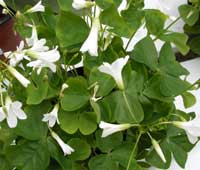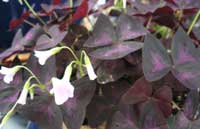Shamrock plant (Oxalis)
History of the Shamrock
The earliest reference to the shamrock was in the 5th century when St. Patrick used the shamrock to explain the Trinity to the Druids. There is no proof that this really happened, however, the shamrock continued to become a part of Irish legend and history. Today in Ireland, the three-lobed leaf is a symbol of Ireland and is proudly worn as a “good luck” badge on St. Patrick’s day.
The “lucky clover” is not the same as the Shamrock plant sold at the grocery stores around St. Patrick’s day. The word shamrock is derived from Celtic word, “trefoil” (three-leafed), or “little clover”. Trifolium repens is the small white clover that is found in lawns and also used as a green manure cover crop. Irish experts consider this to be the true shamrock. Although, others may argue that the yellow flowered (Trifolium dubium) is the real deal. Both are difficult to grow indoors.
The shamrocks sold in grocery stores belong to a large family of Oxalis with over 800 varieties, native to Chile and South Africa. They grow from small corms or tuberous roots which produce delicate, clover-like leaves that are light sensitive and close on cloudy days and at night (nyctinstic movements). The leaves range from a green to purple with flowers that come in a variety of colors; white, cream, yellow, pink, purple and red.
Oxalis regnelli, sold as the shamrock plant, has white flowers and green foliage. Another version, O. triangularis has purple leaves with pinkish to white flowers.

CARE
Indoors – keep in a well-lit location (east or west window) away from hot and cold drafts at temperatures of 60-70F during the day and 55-65F at night. They should be kept barely moist at all times and not allowed to stand in water as that will cause root rot. Fertilize every 2 -4 weeks with a houseplant fertilizer. The plant is relatively pest free.
When finished blooming, the plant may start to die back. Allow it to go dormant for 1-3 months keeping the corms cool and dry. After dormancy, repot and or divide (optional). When signs of new growth emerge, begin to water, fertilize and move to a sunny spot.
Oxalis regnelli and O.triangularis are hardy in zone 6-10. Hardier varieties can be grown outdoors as a nice ground cover. Not only does it make a great houseplant, but the unique foliage can add great accent and color to your outdoor container plantings.
Troubleshooting: Tall & lanky plant – needs more light, too warm (temps over 75)
Yellowing plant – watering too much.
May the luck of the Irish be with you!
Happy St. Patty’s!!
My purple shamrock seems perfectly healthy, receipt it’s turning mostly green on the top of the leaves. Still purple underneath… Ideas?
My healthy purple oxalis is starting to turn bright pink and wilty one by one…the bright pink turns to withered blue green and dead! Help! What do I do?
Hello. I took my shamrock plant in and had a gardening center make 2 pots of them. A few weeks later, I had a lot of fruit flies around both plants. I was told to buy a spray and coat the leaves of the shamrock. But that made the leaves wither and die! Long story short, I cut them off. Now I’ve got a lot of stems. Will the leaves grow back??
Hi there! I have a purple type oxalis that is very, very happy and healthy. In fact, after coming home from vacation where it was allowed to really dry out, but still got plenty of sunlight, it looks as though it’s had a baby! What I’m describing is sort of how spider plants develop new baby plants off of existing growth. My oxalis has a stem that has produced a tangle of new stems far from the base of the plant. I’m wondering if I can use this to propagate a new plant?
Thanks!
My Shamrock plant was rained on and the soil was soaked for 2 days. There wasn no plant yet, or roots so I removed the bare ryzomes, and it looks like they’re molding a little. They’re dark, kind of soft and a little flimsy. I rinsed them off and rubbed off some of the mold and put the ryzomes on a paper towl.
🙁 I’ve had him for 15 years. Will he die? Is there anything I can do to save him?
My plant was getting too crowded in the pot. I put it in the cool, dark garage in October (in Wisconsin). Brought it into the house late November, divided the corms and replanted. I don’t see any activity yet (December 5)..
Does it need a full 3 months dormancy? Should I continue to water? I wonder if I planted the corms upside down…. How to tell the direction of the top of the corn? Any help is appreciated.
My Indoor Shamrock is about 30 years old. It’s been healthy. Blooms, goes dormant then comes back. Beautiful! Now however it seems to be dying. It has white powdery spots on top of the leaves. Probably fungi or mildew. What can I do to get rid of the disease? This plant means a lot to us and I can’t stand the thoughts of loosing it.
Hi Rebecca
See the link for treatment of powdery mildew.
http://hortchat.com/info/powdery-mildew
My green shamrock has gotten darker in color, kind of dull dark green. Anyway to brighten it up again? I’m using Miracle Grow fertilizer.
Hello, I have been searching everywhere online to find out what is wrong with my purple oxalis. The leaves are turning a very ugly light green! Do you know of anything like this and or what I can do to fix it?
I have just inherited a south facing garden with a substantial clump of purple flowering OXALIS in one of the borders. It is crowded in by low lying conifers etc.
It is dominated by a MASS of flowers borne on very lanky drooping stems. The problem is the leaves seem to have virtually disappeared and those remaining are yellow and half ‘eaten’ (it would appear).
Should the plant be sprayed with a general purpose pesticide and/ or given an appropriate mineral supplement and cut back in the autumn?
For several weeks, the garden has been subjected to alternating hot sun and days of heavy rainfall.
Would be grateful if you could advise.
I have had my shamrock for several years. We just moved from AR to KS and my shamrock has little black bugs and the leaves are sticky. Wondering what I can do to alleviate the bugs if that is the problem. Thank you
One of the stems snapped on accident and I am wondering if I can plant it into soil if it will re root again ? It is a purple variety
.